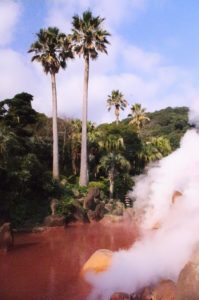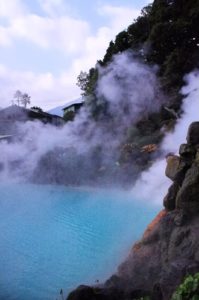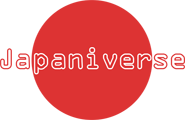Oita is in the northeast of Kyushu, the westernmost of Japan’s four main islands. It is famous for hot springs heated by geothermic activity.
Weather in Oita
Oita is a humid climate with hot summers and chilly winters. It rarely goes below freezing but it will be cold, and summer temperatures average around 25C. Spring and autumn are fairly warm and not as humid as the summer. However, Oita has some unique summer festivals that will make enduring the summer heat worth it! Especially the Beppu Fireworks Festival at the end of July, the biggest fireworks show in Oita. There’s also the Nagahama Shrine Summer Festival, the first of the summer in all of Oita so it’s very popular. Watch people carry portable shrines and play traditional music as they parade through the streets.
Getting Around Oita
Buses are the primary mode of transportation in Oita, run by two main bus service companies. The Oita Bus Company operates bus routes in the city and the Oita Kotsu Company runs north of the city. For long distance bus services, these two companies, as well as Kamenoi Bus Company operate bus routes from Oita to main place of Kyushu, such as Fukuoka and Kumamoto, and Osaka, Nagoya and more.

Top Attractions in Oita
The most unique sight to see in Oita is in the city of Beppu, where the “Eight Hells” are. Nothing to do with religion, the “Hells” are unique spots of geothermal activity, which gives hot springs unusual characteristics. Unlike the rest of Japan, these hot springs are meant to be viewed, not bathed in. The most picturesque of these “Hells” are the “Sea Hell” and the “Blood Hell”, where their pristine light blue and rust red water make for striking photos. Visit all of them with the “Hell Tour”/Jigoku Meguri for ¥2000 or choose a few for ¥400 per entry, open 8:00-17:00. Hop on a bus from JR Beppu Station and take a 15 minute ride to Kannawa bus terminal with bus no. 5, 7, or 9. From there, all of the ‘hells’ can be reached on foot. 
Also in Beppu is Takasaki mountain. It is famous for the tribe of more than 1,500 wild Japanese macaque monkeys that roam around freely, no cages. The Takasakiyama Monkey Park is only 10 minutes away from Beppu by bus. Head there on a day with good weather to watch the monkeys play, and laze about. Just don’t get too close! Try to time it to see a feeding time when the park employees give out food for them, a few times per day. To get there, take bus AS60 or AS61 toward Oita Station, and take a 10-minute ride before getting off at Takasakiyama-Umitamago. The bus runs once an hour and costs ¥410.
The Monkey Park is right next to the Oita Marine Palace Aquarium Umitamago. You can do a 5-minute uphill walk or take a short monorail ride (¥100 round trip). Admission is ¥510.
Visit both with the “Monkey Marine Ticket”, ¥2450, which includes the bus rides and admission to both the money park and the aquarium. That ticket can be bought at the Beppu Station tourist office or the Oita Station Bus Center. The park is open 7 days a week from 8:30-17:00, with final entry at 16:30.
One thing you must experience in Beppu is the large outdoor mud hot spring at Hoyoland! It’s ¥1100 per entry. The sulfuric mud is fantastic for skin, and people from all over Japan come to Beppu for their famous hot springs. The baths are open from 09:00 to 22:00, with an earlier closing time of 20:00 on Mondays.The two main baths are outside and mixed gender, men on one side and women on the other side of the divider, because the mud makes the water opaque enough to conceal your body. The entrance into the open bath is low enough that you have to crabwalk and won’t accidentally walk into the open outside. It’s a fun activity for your entire group of travel mates. Of course, there’s separated baths and saunas inside if the mixed baths are not your thing. From Beppu Station, take the Kamenoi bus bound for Ritsumeikan Asia Pacific University and get off at the Konya Jigoku Mae stop. It takes around 25 minutes one-way.
Food in Oita
The food you should try in Oita is exceptionally fresh seafood like like horse mackerel (seki-aji) and blowfish (fugu), as well as marbled Bungo beef and tori-ten, marinated deep-fried chicken. There’s also dangojiru, a miso soup-based soup with noodles and local vegetables like taro, shiitake mushrooms, and onions.
For a break to do some shopping and have some lunch, JR Oita City is a perfect pit stop, and conveniently built around JR Oita Station. There’s also the nearby Cent Porta Chuomachi which boasts an outdoor shopping arcade.
Oita is a worthy stop on a Kyushu tour just for its natural wonders. The Hells and Monkey Park make for great photos and stories, and the mud hot springs will be an experience you’ll always remember! Definitely hop a bus and reserve a few days to explore this lovely corner of Japan.
